PS766 Risk Assessment Report: Analyzing Mr. Dexter's Violent Behavior
VerifiedAdded on 2022/12/28
|7
|1949
|28
Report
AI Summary
This report presents a risk assessment of Mr. Dexter, focusing on his violent behavior and the factors contributing to it. The report begins with an introduction emphasizing the importance of analyzing the risk of violence and the use of risk assessment tools. The main body details long-term risk factors, including trauma, aggression, alcohol use, and personality disorders. It then assesses Mr. Dexter's case using the DANGER ASSESSMENT TOOL and STAMP, considering his past offenses, current behavior, and potential for future violence. The report identifies factors influencing short-term risk and provides recommendations for risk management, emphasizing the need for therapeutic interventions and awareness. The conclusion summarizes the key findings and reinforces the significance of evidence-based practices in addressing violent behavior.

Risk Assessment Report
Paraphrase This Document
Need a fresh take? Get an instant paraphrase of this document with our AI Paraphraser
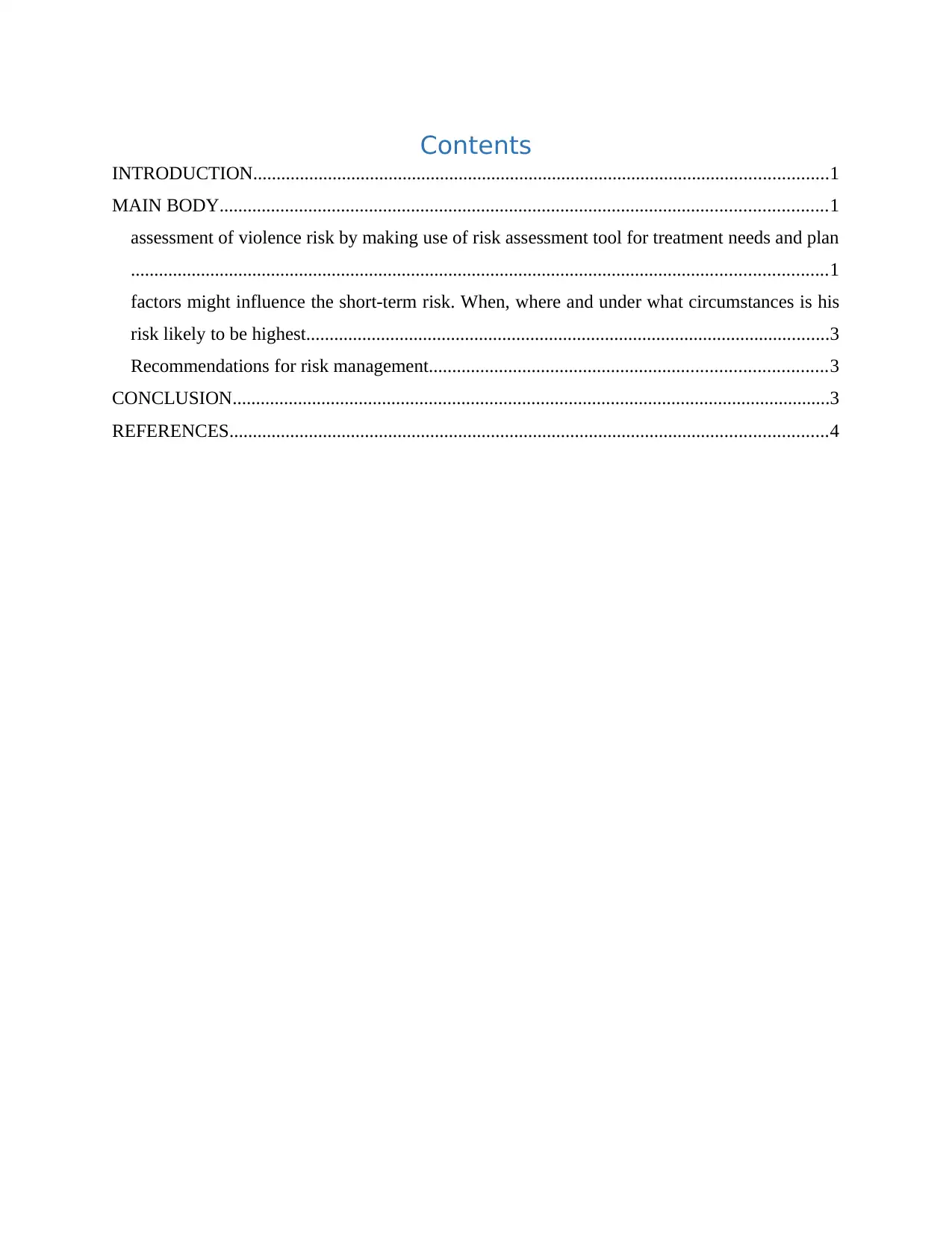
Contents
INTRODUCTION...........................................................................................................................1
MAIN BODY..................................................................................................................................1
assessment of violence risk by making use of risk assessment tool for treatment needs and plan
.....................................................................................................................................................1
factors might influence the short-term risk. When, where and under what circumstances is his
risk likely to be highest................................................................................................................3
Recommendations for risk management.....................................................................................3
CONCLUSION................................................................................................................................3
REFERENCES................................................................................................................................4
INTRODUCTION...........................................................................................................................1
MAIN BODY..................................................................................................................................1
assessment of violence risk by making use of risk assessment tool for treatment needs and plan
.....................................................................................................................................................1
factors might influence the short-term risk. When, where and under what circumstances is his
risk likely to be highest................................................................................................................3
Recommendations for risk management.....................................................................................3
CONCLUSION................................................................................................................................3
REFERENCES................................................................................................................................4
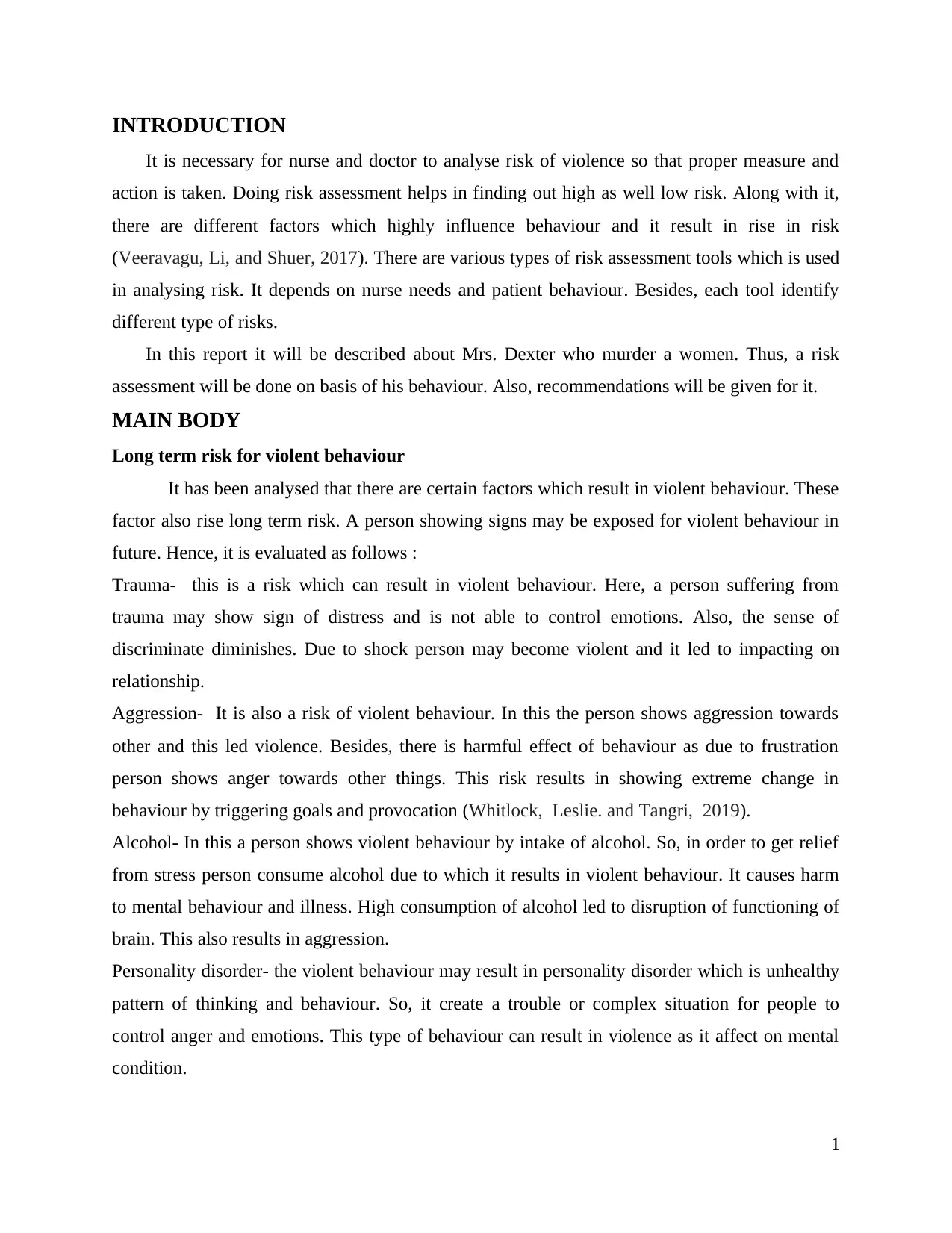
INTRODUCTION
It is necessary for nurse and doctor to analyse risk of violence so that proper measure and
action is taken. Doing risk assessment helps in finding out high as well low risk. Along with it,
there are different factors which highly influence behaviour and it result in rise in risk
(Veeravagu, Li, and Shuer, 2017). There are various types of risk assessment tools which is used
in analysing risk. It depends on nurse needs and patient behaviour. Besides, each tool identify
different type of risks.
In this report it will be described about Mrs. Dexter who murder a women. Thus, a risk
assessment will be done on basis of his behaviour. Also, recommendations will be given for it.
MAIN BODY
Long term risk for violent behaviour
It has been analysed that there are certain factors which result in violent behaviour. These
factor also rise long term risk. A person showing signs may be exposed for violent behaviour in
future. Hence, it is evaluated as follows :
Trauma- this is a risk which can result in violent behaviour. Here, a person suffering from
trauma may show sign of distress and is not able to control emotions. Also, the sense of
discriminate diminishes. Due to shock person may become violent and it led to impacting on
relationship.
Aggression- It is also a risk of violent behaviour. In this the person shows aggression towards
other and this led violence. Besides, there is harmful effect of behaviour as due to frustration
person shows anger towards other things. This risk results in showing extreme change in
behaviour by triggering goals and provocation (Whitlock, Leslie. and Tangri, 2019).
Alcohol- In this a person shows violent behaviour by intake of alcohol. So, in order to get relief
from stress person consume alcohol due to which it results in violent behaviour. It causes harm
to mental behaviour and illness. High consumption of alcohol led to disruption of functioning of
brain. This also results in aggression.
Personality disorder- the violent behaviour may result in personality disorder which is unhealthy
pattern of thinking and behaviour. So, it create a trouble or complex situation for people to
control anger and emotions. This type of behaviour can result in violence as it affect on mental
condition.
1
It is necessary for nurse and doctor to analyse risk of violence so that proper measure and
action is taken. Doing risk assessment helps in finding out high as well low risk. Along with it,
there are different factors which highly influence behaviour and it result in rise in risk
(Veeravagu, Li, and Shuer, 2017). There are various types of risk assessment tools which is used
in analysing risk. It depends on nurse needs and patient behaviour. Besides, each tool identify
different type of risks.
In this report it will be described about Mrs. Dexter who murder a women. Thus, a risk
assessment will be done on basis of his behaviour. Also, recommendations will be given for it.
MAIN BODY
Long term risk for violent behaviour
It has been analysed that there are certain factors which result in violent behaviour. These
factor also rise long term risk. A person showing signs may be exposed for violent behaviour in
future. Hence, it is evaluated as follows :
Trauma- this is a risk which can result in violent behaviour. Here, a person suffering from
trauma may show sign of distress and is not able to control emotions. Also, the sense of
discriminate diminishes. Due to shock person may become violent and it led to impacting on
relationship.
Aggression- It is also a risk of violent behaviour. In this the person shows aggression towards
other and this led violence. Besides, there is harmful effect of behaviour as due to frustration
person shows anger towards other things. This risk results in showing extreme change in
behaviour by triggering goals and provocation (Whitlock, Leslie. and Tangri, 2019).
Alcohol- In this a person shows violent behaviour by intake of alcohol. So, in order to get relief
from stress person consume alcohol due to which it results in violent behaviour. It causes harm
to mental behaviour and illness. High consumption of alcohol led to disruption of functioning of
brain. This also results in aggression.
Personality disorder- the violent behaviour may result in personality disorder which is unhealthy
pattern of thinking and behaviour. So, it create a trouble or complex situation for people to
control anger and emotions. This type of behaviour can result in violence as it affect on mental
condition.
1
⊘ This is a preview!⊘
Do you want full access?
Subscribe today to unlock all pages.

Trusted by 1+ million students worldwide
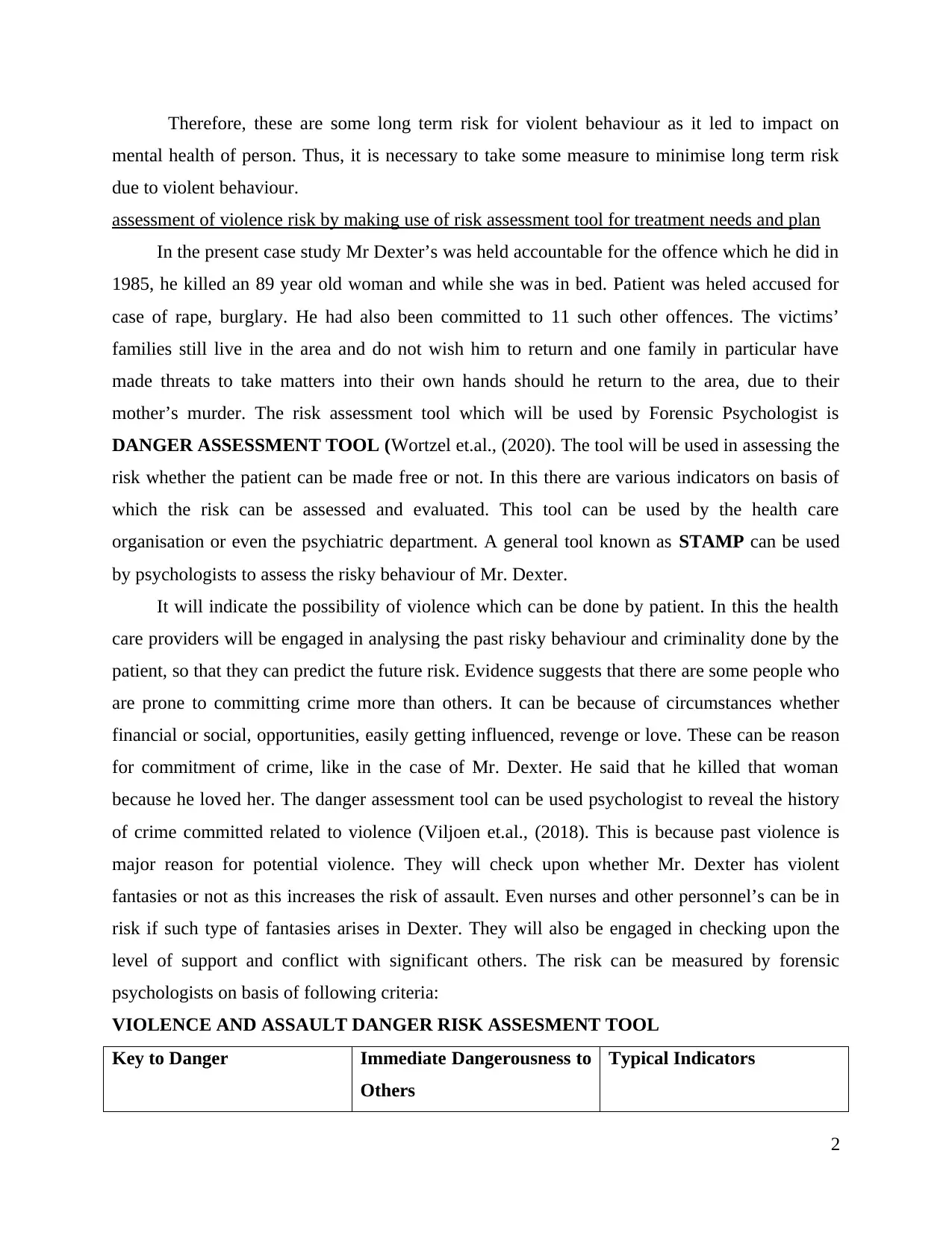
Therefore, these are some long term risk for violent behaviour as it led to impact on
mental health of person. Thus, it is necessary to take some measure to minimise long term risk
due to violent behaviour.
assessment of violence risk by making use of risk assessment tool for treatment needs and plan
In the present case study Mr Dexter’s was held accountable for the offence which he did in
1985, he killed an 89 year old woman and while she was in bed. Patient was heled accused for
case of rape, burglary. He had also been committed to 11 such other offences. The victims’
families still live in the area and do not wish him to return and one family in particular have
made threats to take matters into their own hands should he return to the area, due to their
mother’s murder. The risk assessment tool which will be used by Forensic Psychologist is
DANGER ASSESSMENT TOOL (Wortzel et.al., (2020). The tool will be used in assessing the
risk whether the patient can be made free or not. In this there are various indicators on basis of
which the risk can be assessed and evaluated. This tool can be used by the health care
organisation or even the psychiatric department. A general tool known as STAMP can be used
by psychologists to assess the risky behaviour of Mr. Dexter.
It will indicate the possibility of violence which can be done by patient. In this the health
care providers will be engaged in analysing the past risky behaviour and criminality done by the
patient, so that they can predict the future risk. Evidence suggests that there are some people who
are prone to committing crime more than others. It can be because of circumstances whether
financial or social, opportunities, easily getting influenced, revenge or love. These can be reason
for commitment of crime, like in the case of Mr. Dexter. He said that he killed that woman
because he loved her. The danger assessment tool can be used psychologist to reveal the history
of crime committed related to violence (Viljoen et.al., (2018). This is because past violence is
major reason for potential violence. They will check upon whether Mr. Dexter has violent
fantasies or not as this increases the risk of assault. Even nurses and other personnel’s can be in
risk if such type of fantasies arises in Dexter. They will also be engaged in checking upon the
level of support and conflict with significant others. The risk can be measured by forensic
psychologists on basis of following criteria:
VIOLENCE AND ASSAULT DANGER RISK ASSESMENT TOOL
Key to Danger Immediate Dangerousness to
Others
Typical Indicators
2
mental health of person. Thus, it is necessary to take some measure to minimise long term risk
due to violent behaviour.
assessment of violence risk by making use of risk assessment tool for treatment needs and plan
In the present case study Mr Dexter’s was held accountable for the offence which he did in
1985, he killed an 89 year old woman and while she was in bed. Patient was heled accused for
case of rape, burglary. He had also been committed to 11 such other offences. The victims’
families still live in the area and do not wish him to return and one family in particular have
made threats to take matters into their own hands should he return to the area, due to their
mother’s murder. The risk assessment tool which will be used by Forensic Psychologist is
DANGER ASSESSMENT TOOL (Wortzel et.al., (2020). The tool will be used in assessing the
risk whether the patient can be made free or not. In this there are various indicators on basis of
which the risk can be assessed and evaluated. This tool can be used by the health care
organisation or even the psychiatric department. A general tool known as STAMP can be used
by psychologists to assess the risky behaviour of Mr. Dexter.
It will indicate the possibility of violence which can be done by patient. In this the health
care providers will be engaged in analysing the past risky behaviour and criminality done by the
patient, so that they can predict the future risk. Evidence suggests that there are some people who
are prone to committing crime more than others. It can be because of circumstances whether
financial or social, opportunities, easily getting influenced, revenge or love. These can be reason
for commitment of crime, like in the case of Mr. Dexter. He said that he killed that woman
because he loved her. The danger assessment tool can be used psychologist to reveal the history
of crime committed related to violence (Viljoen et.al., (2018). This is because past violence is
major reason for potential violence. They will check upon whether Mr. Dexter has violent
fantasies or not as this increases the risk of assault. Even nurses and other personnel’s can be in
risk if such type of fantasies arises in Dexter. They will also be engaged in checking upon the
level of support and conflict with significant others. The risk can be measured by forensic
psychologists on basis of following criteria:
VIOLENCE AND ASSAULT DANGER RISK ASSESMENT TOOL
Key to Danger Immediate Dangerousness to
Others
Typical Indicators
2
Paraphrase This Document
Need a fresh take? Get an instant paraphrase of this document with our AI Paraphraser
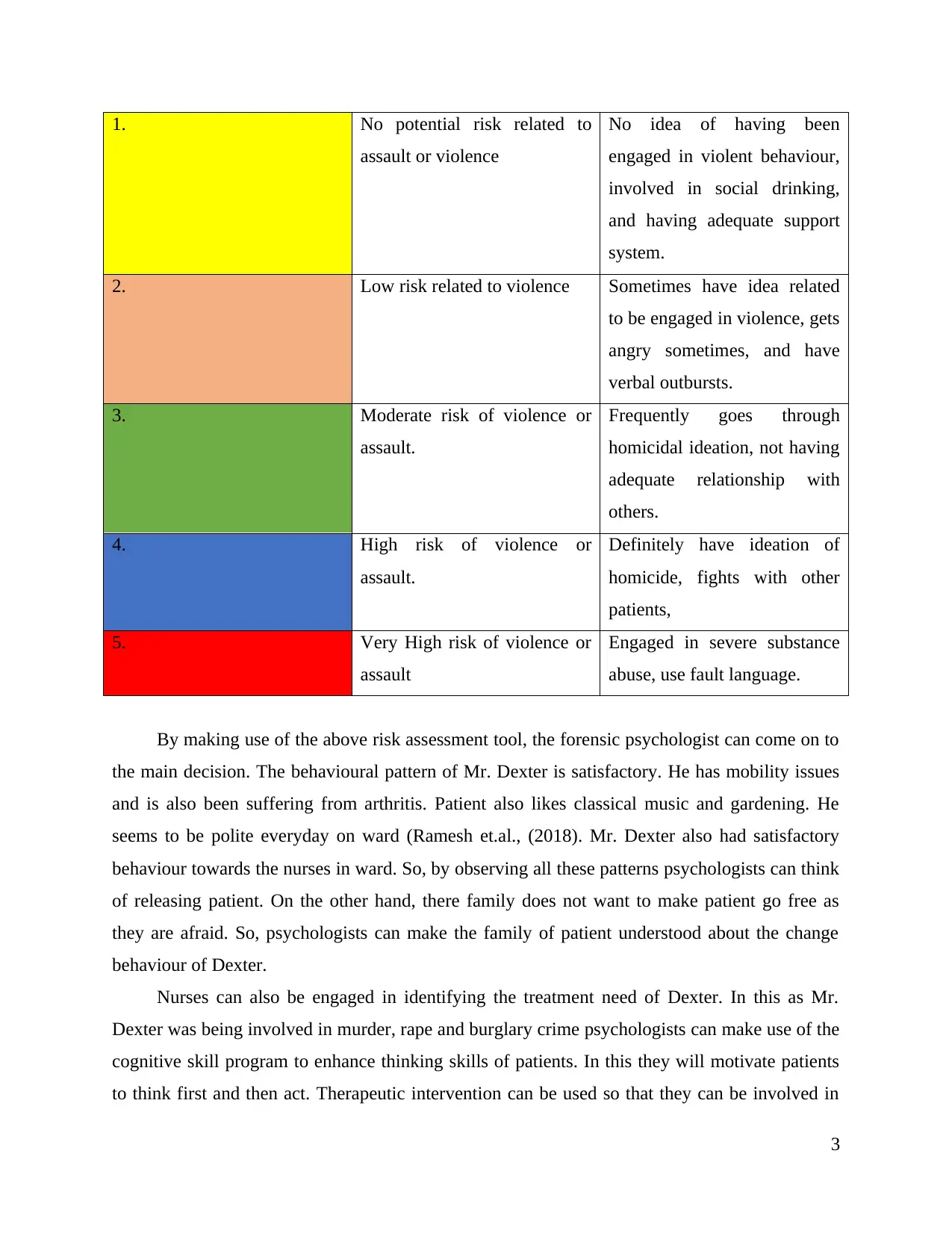
1. No potential risk related to
assault or violence
No idea of having been
engaged in violent behaviour,
involved in social drinking,
and having adequate support
system.
2. Low risk related to violence Sometimes have idea related
to be engaged in violence, gets
angry sometimes, and have
verbal outbursts.
3. Moderate risk of violence or
assault.
Frequently goes through
homicidal ideation, not having
adequate relationship with
others.
4. High risk of violence or
assault.
Definitely have ideation of
homicide, fights with other
patients,
5. Very High risk of violence or
assault
Engaged in severe substance
abuse, use fault language.
By making use of the above risk assessment tool, the forensic psychologist can come on to
the main decision. The behavioural pattern of Mr. Dexter is satisfactory. He has mobility issues
and is also been suffering from arthritis. Patient also likes classical music and gardening. He
seems to be polite everyday on ward (Ramesh et.al., (2018). Mr. Dexter also had satisfactory
behaviour towards the nurses in ward. So, by observing all these patterns psychologists can think
of releasing patient. On the other hand, there family does not want to make patient go free as
they are afraid. So, psychologists can make the family of patient understood about the change
behaviour of Dexter.
Nurses can also be engaged in identifying the treatment need of Dexter. In this as Mr.
Dexter was being involved in murder, rape and burglary crime psychologists can make use of the
cognitive skill program to enhance thinking skills of patients. In this they will motivate patients
to think first and then act. Therapeutic intervention can be used so that they can be involved in
3
assault or violence
No idea of having been
engaged in violent behaviour,
involved in social drinking,
and having adequate support
system.
2. Low risk related to violence Sometimes have idea related
to be engaged in violence, gets
angry sometimes, and have
verbal outbursts.
3. Moderate risk of violence or
assault.
Frequently goes through
homicidal ideation, not having
adequate relationship with
others.
4. High risk of violence or
assault.
Definitely have ideation of
homicide, fights with other
patients,
5. Very High risk of violence or
assault
Engaged in severe substance
abuse, use fault language.
By making use of the above risk assessment tool, the forensic psychologist can come on to
the main decision. The behavioural pattern of Mr. Dexter is satisfactory. He has mobility issues
and is also been suffering from arthritis. Patient also likes classical music and gardening. He
seems to be polite everyday on ward (Ramesh et.al., (2018). Mr. Dexter also had satisfactory
behaviour towards the nurses in ward. So, by observing all these patterns psychologists can think
of releasing patient. On the other hand, there family does not want to make patient go free as
they are afraid. So, psychologists can make the family of patient understood about the change
behaviour of Dexter.
Nurses can also be engaged in identifying the treatment need of Dexter. In this as Mr.
Dexter was being involved in murder, rape and burglary crime psychologists can make use of the
cognitive skill program to enhance thinking skills of patients. In this they will motivate patients
to think first and then act. Therapeutic intervention can be used so that they can be involved in
3
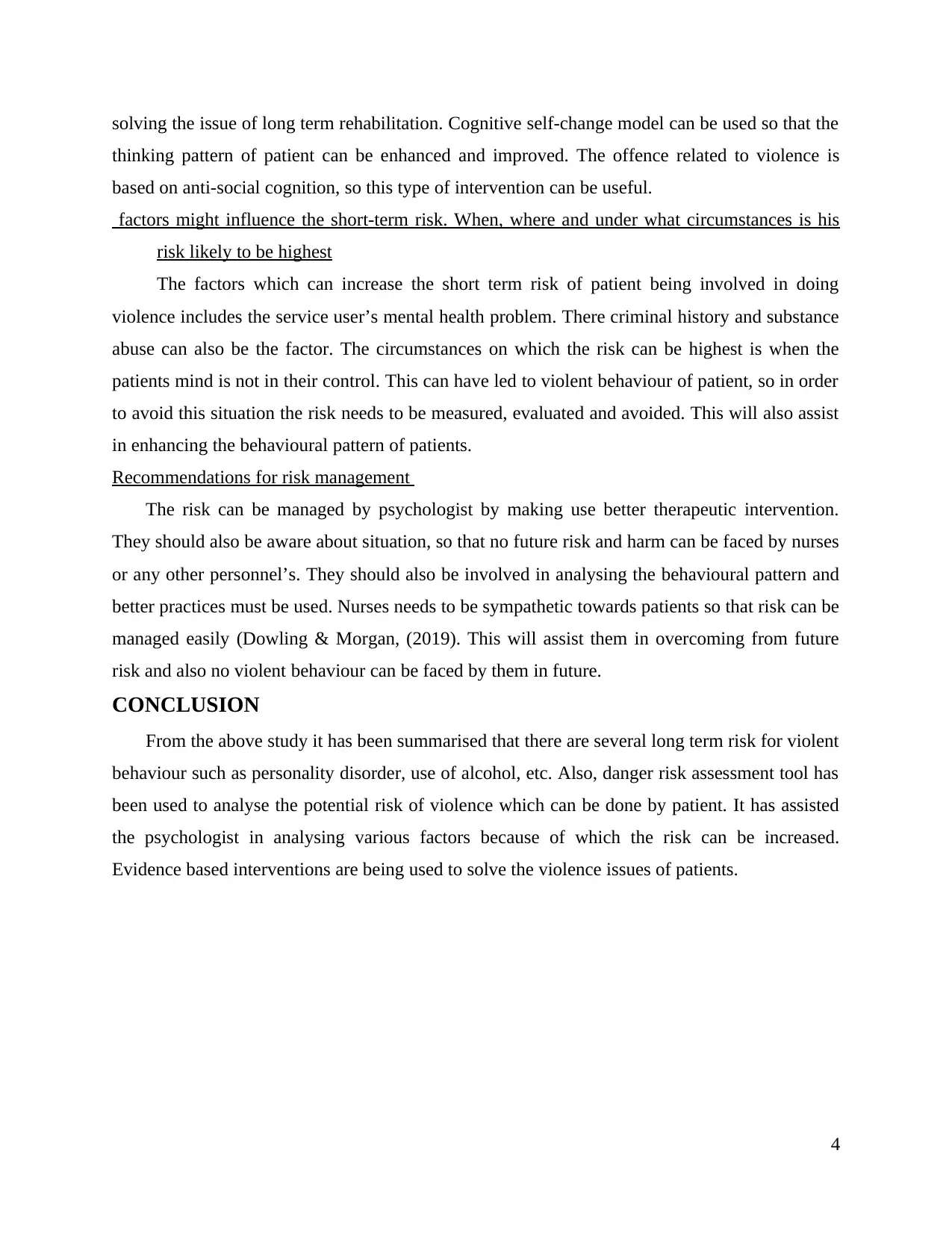
solving the issue of long term rehabilitation. Cognitive self-change model can be used so that the
thinking pattern of patient can be enhanced and improved. The offence related to violence is
based on anti-social cognition, so this type of intervention can be useful.
factors might influence the short-term risk. When, where and under what circumstances is his
risk likely to be highest
The factors which can increase the short term risk of patient being involved in doing
violence includes the service user’s mental health problem. There criminal history and substance
abuse can also be the factor. The circumstances on which the risk can be highest is when the
patients mind is not in their control. This can have led to violent behaviour of patient, so in order
to avoid this situation the risk needs to be measured, evaluated and avoided. This will also assist
in enhancing the behavioural pattern of patients.
Recommendations for risk management
The risk can be managed by psychologist by making use better therapeutic intervention.
They should also be aware about situation, so that no future risk and harm can be faced by nurses
or any other personnel’s. They should also be involved in analysing the behavioural pattern and
better practices must be used. Nurses needs to be sympathetic towards patients so that risk can be
managed easily (Dowling & Morgan, (2019). This will assist them in overcoming from future
risk and also no violent behaviour can be faced by them in future.
CONCLUSION
From the above study it has been summarised that there are several long term risk for violent
behaviour such as personality disorder, use of alcohol, etc. Also, danger risk assessment tool has
been used to analyse the potential risk of violence which can be done by patient. It has assisted
the psychologist in analysing various factors because of which the risk can be increased.
Evidence based interventions are being used to solve the violence issues of patients.
4
thinking pattern of patient can be enhanced and improved. The offence related to violence is
based on anti-social cognition, so this type of intervention can be useful.
factors might influence the short-term risk. When, where and under what circumstances is his
risk likely to be highest
The factors which can increase the short term risk of patient being involved in doing
violence includes the service user’s mental health problem. There criminal history and substance
abuse can also be the factor. The circumstances on which the risk can be highest is when the
patients mind is not in their control. This can have led to violent behaviour of patient, so in order
to avoid this situation the risk needs to be measured, evaluated and avoided. This will also assist
in enhancing the behavioural pattern of patients.
Recommendations for risk management
The risk can be managed by psychologist by making use better therapeutic intervention.
They should also be aware about situation, so that no future risk and harm can be faced by nurses
or any other personnel’s. They should also be involved in analysing the behavioural pattern and
better practices must be used. Nurses needs to be sympathetic towards patients so that risk can be
managed easily (Dowling & Morgan, (2019). This will assist them in overcoming from future
risk and also no violent behaviour can be faced by them in future.
CONCLUSION
From the above study it has been summarised that there are several long term risk for violent
behaviour such as personality disorder, use of alcohol, etc. Also, danger risk assessment tool has
been used to analyse the potential risk of violence which can be done by patient. It has assisted
the psychologist in analysing various factors because of which the risk can be increased.
Evidence based interventions are being used to solve the violence issues of patients.
4
⊘ This is a preview!⊘
Do you want full access?
Subscribe today to unlock all pages.

Trusted by 1+ million students worldwide
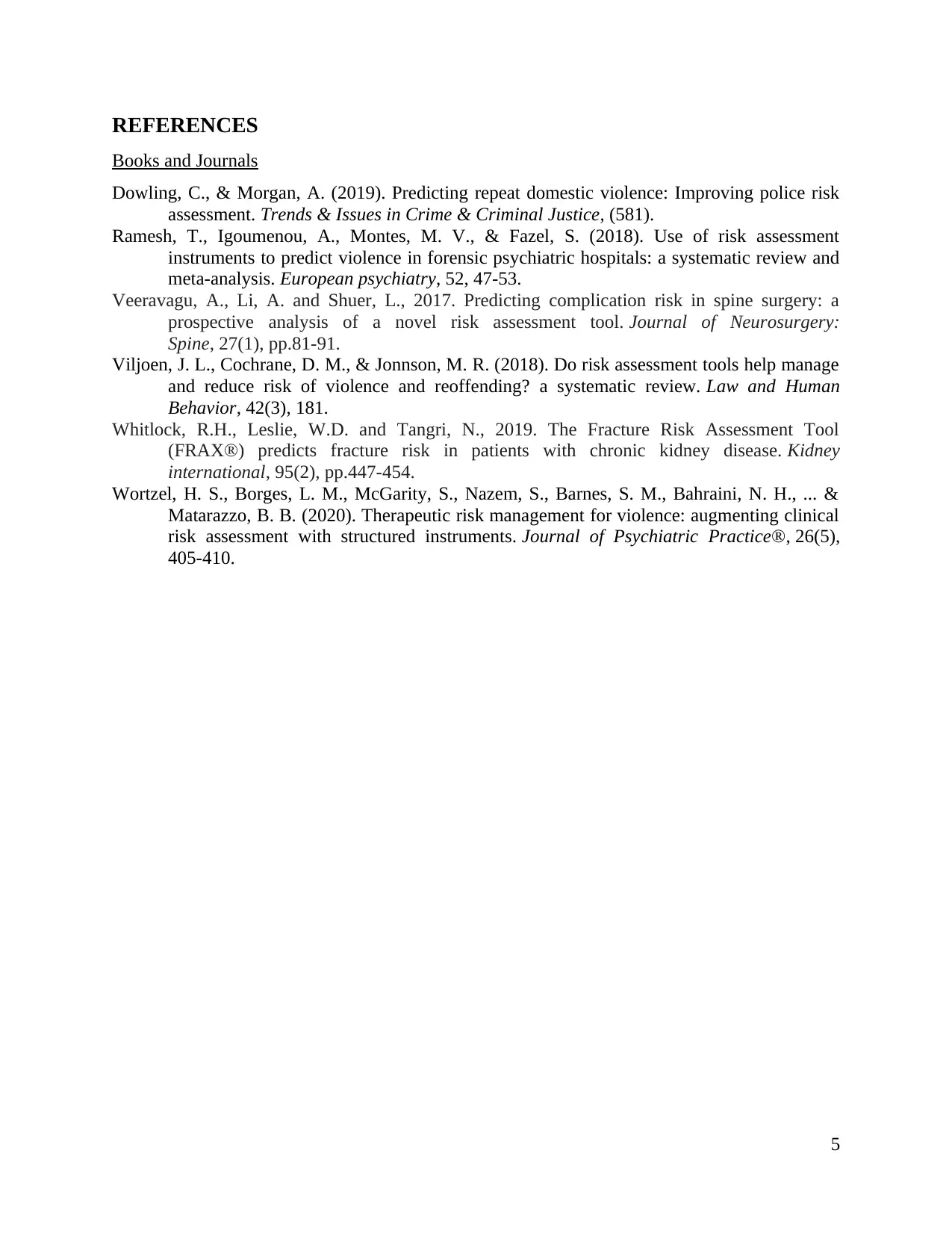
REFERENCES
Books and Journals
Dowling, C., & Morgan, A. (2019). Predicting repeat domestic violence: Improving police risk
assessment. Trends & Issues in Crime & Criminal Justice, (581).
Ramesh, T., Igoumenou, A., Montes, M. V., & Fazel, S. (2018). Use of risk assessment
instruments to predict violence in forensic psychiatric hospitals: a systematic review and
meta-analysis. European psychiatry, 52, 47-53.
Veeravagu, A., Li, A. and Shuer, L., 2017. Predicting complication risk in spine surgery: a
prospective analysis of a novel risk assessment tool. Journal of Neurosurgery:
Spine, 27(1), pp.81-91.
Viljoen, J. L., Cochrane, D. M., & Jonnson, M. R. (2018). Do risk assessment tools help manage
and reduce risk of violence and reoffending? a systematic review. Law and Human
Behavior, 42(3), 181.
Whitlock, R.H., Leslie, W.D. and Tangri, N., 2019. The Fracture Risk Assessment Tool
(FRAX®) predicts fracture risk in patients with chronic kidney disease. Kidney
international, 95(2), pp.447-454.
Wortzel, H. S., Borges, L. M., McGarity, S., Nazem, S., Barnes, S. M., Bahraini, N. H., ... &
Matarazzo, B. B. (2020). Therapeutic risk management for violence: augmenting clinical
risk assessment with structured instruments. Journal of Psychiatric Practice®, 26(5),
405-410.
5
Books and Journals
Dowling, C., & Morgan, A. (2019). Predicting repeat domestic violence: Improving police risk
assessment. Trends & Issues in Crime & Criminal Justice, (581).
Ramesh, T., Igoumenou, A., Montes, M. V., & Fazel, S. (2018). Use of risk assessment
instruments to predict violence in forensic psychiatric hospitals: a systematic review and
meta-analysis. European psychiatry, 52, 47-53.
Veeravagu, A., Li, A. and Shuer, L., 2017. Predicting complication risk in spine surgery: a
prospective analysis of a novel risk assessment tool. Journal of Neurosurgery:
Spine, 27(1), pp.81-91.
Viljoen, J. L., Cochrane, D. M., & Jonnson, M. R. (2018). Do risk assessment tools help manage
and reduce risk of violence and reoffending? a systematic review. Law and Human
Behavior, 42(3), 181.
Whitlock, R.H., Leslie, W.D. and Tangri, N., 2019. The Fracture Risk Assessment Tool
(FRAX®) predicts fracture risk in patients with chronic kidney disease. Kidney
international, 95(2), pp.447-454.
Wortzel, H. S., Borges, L. M., McGarity, S., Nazem, S., Barnes, S. M., Bahraini, N. H., ... &
Matarazzo, B. B. (2020). Therapeutic risk management for violence: augmenting clinical
risk assessment with structured instruments. Journal of Psychiatric Practice®, 26(5),
405-410.
5
1 out of 7
Related Documents
Your All-in-One AI-Powered Toolkit for Academic Success.
+13062052269
info@desklib.com
Available 24*7 on WhatsApp / Email
![[object Object]](/_next/static/media/star-bottom.7253800d.svg)
Unlock your academic potential
Copyright © 2020–2026 A2Z Services. All Rights Reserved. Developed and managed by ZUCOL.





